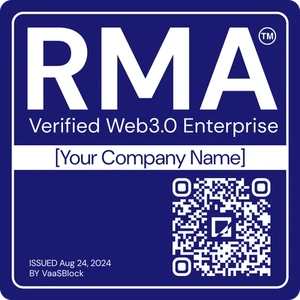
Vultisig
Risk Management
?Risk Management
The RMA™ is a blockchain credibility certification assessing governance, transparency, security, and results, providing trusted verification for businesses in Web3.
VaaSBlock has not audited this project and cannot vouch for this organization.
RMA™ Status: ❌ Unverified
Verification of 6 major compliance criteria.
Technology
?Technology
A collection of public facing information, data collected through partners and our own tools view we present a projects technology in one place for easy verification.
Analysis and testing of tech infrastructures.
Marketing
Alpha?Marketing
Top level look at a projects marketing capablities currently in alpha this section will grow to show quickly how a project promotes itself and the effectiveness.
Screening of user base and community feedback.
Background
?Background
Using multiple public facing sources across the web view a summary of a projects purpose, key achievements and general overview.
Collection of basic administrative documentation.
Risk Management
Last Updated
2025/4/16
Transparency
Transparency Score
Algorithmic assessment of a project’s transparency level, using multiple public data points to measure its commitment to compliance, documentation, and clarity in communication.
Transparency Score
Category Rank
A ranking that positions the organization among its industry peers, evaluating its relative performance based on key compliance, credibility, and transparency indicators.
Category Rank
Vultisig vs Payment
VaaSBlock Rank
A global ranking that compares the organization against all entities listed on VaaSBlock, reflecting its overall credibility, transparency, and operational performance versus the full Web3 ecosystem.
VaaSBlock Rank
Vultisig vs All Listed Organizations
Transparency
Transparency Score
Transparency Score
Algorithmic assessment of a project’s transparency level, using multiple public data points to measure its commitment to compliance, documentation, and clarity in communication.
Category Rank
Vultisig vs Payment
Category Rank
A ranking that positions the organization among its industry peers, evaluating its relative performance based on key compliance, credibility, and transparency indicators.
VaaSBlock Rank
Vultisig vs All Listed Organizations
VaaSBlock Rank
A global ranking that compares the organization against all entities listed on VaaSBlock, reflecting its overall credibility, transparency, and operational performance versus the full Web3 ecosystem.
RMA™
✘ UnverifiedCorporate Governance
The verification of fundamental governance, organizational structure, including verifying the entity’s legal registration and adherence to local laws and regulations.
Corporate
Governance

Team Proficency
Evaluation of an organization’s personnel, ensuring that crucial team members possess the expertise and dedication necessary to execute current business models and scale effectively.
Team
Proficiency

Technology & Security
Assessment of the organization’s technological framework, including blockchain integrations (where relevant), system architecture, and overall IT infrastructure.
Technology
& Security

Revenue Model
Comprehensively evaluation of a company’s income-generating strategies (how do they make or intend to make money), ensuring financial robustness and sustainability.
Revenue
Model

Results Delivered
The Results Delivered component of the RMA™ audit comprehensively evaluates an organization’s ability to achieve its goals and honor its commitments.
Results
Delivered

Planning & Transparency
The Planning and Transparency component of the RMA™ audit offers a thorough assessment of how an organization manages its workflow and prepares for unexpected challenges.
Planning &
Transparency

Technology
Marketing
Marketing Effectiveness
This score assesses the impact of detected marketing activity and the corresponding price movement of a token. The score understands whole market movements to ensure tokens are assessed fairly against peers.
Marketing Effectiveness
Confidence Index
This index determines our confidence in the score we have given. Generally, as more data is collected, the confidence index will increase. If a project has lots of activity, this confidence is earned faster.
Confidence Index
VaaSBlock Rank
This identifies where a project sits compared to all projects accessed for Marketing Effectiveness.
VaaSBlock Rank
Vultisig vs All Listed Organizations
Marketing Effectiveness
Marketing Effectiveness
This score assesses the impact of detected marketing activity and the corresponding price movement of a token. The score understands whole market movements to ensure tokens are assessed fairly against peers.
Confidence Index
Confidence Index
This index determines our confidence in the score we have given. Generally, as more data is collected, the confidence index will increase. If a project has lots of activity, this confidence is earned faster.
VaaSBlock Rank
Vultisig vs All Listed Organizations
VaaSBlock Rank
This identifies where a project sits compared to all projects accessed for Marketing Effectiveness.
No Chain No Gain™ Podcast ⛉
This Organization is yet to join the No Chain No Gain™ Podcast and share insights on what makes their business trustable and innovative.
💡 NCNG generated over 1 Million impressions in its first six months of existence.
PR Impact
PR Impact
VaaSBlock provides estimations to the impact that traditional digital media can have on a project. This is an early release; more areas of PR are planned in future versions.
Search Terms ? Search TermsThese are the terms we discovered the article for on page one of Google. | Est. Traffic ? Estimated TrafficWe estimate how much traffic an article will get. Generally, our estimations are slightly higher than those of more established tools. We are working on the algorithm all the time, and results could change. | Est. Value ? Estimated ValueBased on the estimated traffic we generate an estimation for what this traffic would have cost to generate if you tried to target these users with ads. The positions for the article on google and the location of the traffic are the major factors in this estimation. | |||
|---|---|---|---|---|---|
Vultisig: Secure Crypto Vault source: github.com | Vultisig: Secure Cry… — Vultisig: Secure Crypto Vault source: github.com | Organic | github.com | ||
Vultisig The Privacy By Default Defi Wallet 4ffce5f82375 source: Medium | Vultisig The Privacy… Seen 2025-02-22T19:00:00.000Z Vultisig The Privacy By Default Defi Wallet 4ffce5f82375 source: Medium | Organic | thorchain-community.medium.com | ||
Vultisig: Secure Crypto Vault source: github.com | Vultisig: Secure Cry… Seen 2025-02-22T19:00:00.000Z Vultisig: Secure Crypto Vault source: github.com | Organic | github.com | ||
Vultisig: Secure Crypto Vault source: github.com | Vultisig: Secure Cry… Seen 2025-02-22T19:00:00.000Z Vultisig: Secure Crypto Vault source: github.com | Organic | linktr.ee |
| Est. Traffic | Est. Value | ||
|---|---|---|---|
Vultisig: Secure Cry… — | |||
Vultisig The Privacy… Seen 2025-02-22T19:00:00.000Z | |||
Vultisig: Secure Cry… Seen 2025-02-22T19:00:00.000Z | |||
Vultisig: Secure Cry… Seen 2025-02-22T19:00:00.000Z |
Ratings
AlphaOverall
Aggregated Rating
The combined score with AI-driven weighted analysis to provide the best possible project rating.
244 verifications
Confidence Index
This index determines our confidence in the score we have given. Generally, as more data is collected, the confidence index will increase. If a project has lots of activity, this confidence is earned faster.
Low
244 verifications
External Reviews
Third-party reviews are important for your reputation.We incorporate them into our Deep Due Diligence framework to provide a more comprehensive and transparent evaluation of each project. Collaborating with VaaSBlock ensures your reviews are not only acknowledged but actively contribute to building trust, improving your credibility, and maximizing the impact of your public reputation. Work with us now.
Background
Organization Name – Vultisig
Category –  Payment
Payment
About
powered by irmaAI
irmaAIVultisig is a decentralized crypto wallet designed to bring institutional-grade security to everyday users by eliminating traditional single points of failure. Launched in 2025, Vultisig combines mult…i-party computation (MPC) and threshold signature schemes (TSS) to enable secure, programmable wallet access across multiple devices and platforms. It targets users and organizations looking for enhanced security and usability without relying on hardware wallets or seed phrases.
The core innovation behind Vultisig is its distributed vault architecture. Instead of storing a full private key in one place, the wallet splits the key into multiple “shares” across different devices. For example, a vault might require a 2-of-3 or 3-of-5 setup to authorize transactions. This ensures that no single compromised device can compromise the wallet. Users can configure their vaults according to their risk profile, combining mobile devices, desktops, and cloud-based environments to meet their security needs.
The wallet is fully non-custodial and open-source. Users retain control over their assets at all times, and the infrastructure has been built for multi-chain support from the start. As of mid-2025, Vultisig supports major chains like Bitcoin, Ethereum, Solana, Binance Smart Chain, and THORChain. This makes it versatile for both everyday crypto users and DeFi power users.
Another significant strength of the platform is its multi-platform accessibility. The Vultisig app is available on iOS, Android, Windows, Linux, and the web. This ensures seamless access for users across devices, which is especially useful in the event of device loss or replacement. Synchronizing vault shares across different devices enables secure recovery and uninterrupted access.
Vultisig also launched VultiConnect, a browser extension that allows users to interact directly with decentralized applications (dApps). VultiConnect provides dApp connectivity for signing transactions using the MPC-based vault, effectively integrating the wallet into the wider Web3 ecosystem. It works similarly to MetaMask but with the added security of multi-party computation and no single private key exposure.
To support and govern the platform, Vultisig introduced its native token, $VULT. This utility and governance token has multiple roles. Users who hold and stake $VULT can access enhanced wallet features and receive preferential fees on certain services. Stakers also participate in governance, voting on new platform features, plugins, fee structures, and other protocol-level decisions.
In addition, $VULT is used in the platform’s cashback system. Users who interact with features such as swaps, bridges, and plugin services receive USDC rewards distributed from revenue collected by the platform. The cashback feature is an incentive model designed to reward active engagement with the Vultisig ecosystem and create a sustainable reward loop for token holders.
The tokenomics of $VULT are designed to support long-term growth. The total supply is capped at 100 million tokens. Of this, 35% was allocated to launch liquidity and community access, 24% to early investors with a one-year lock and vesting schedule, and 17.3% to the team with a four-year vesting timeline. An additional 6% was allocated for community airdrops and incentives to bootstrap early adoption.
One of the key user acquisition strategies for Vultisig is its airdrop program. Participants are rewarded with $VULT tokens based on their activity and the value of assets they store in their vaults. The program uses a points system that considers both the quantity and duration of assets stored. This approach not only rewards loyal users but also helps to build sticky retention early in the product’s lifecycle.
The Vultisig platform includes a marketplace for modular plugins and AI agents. These plugins can be created by the community and offer features such as DeFi strategy automation, portfolio management, and trading signals. Developers are incentivized to create and sell plugins through the Vultisig store, opening up new monetization channels for contributors. This extensibility transforms Vultisig from a wallet into a customizable crypto operating system.
Security remains at the heart of Vultisig’s mission. The use of MPC and TSS ensures that no individual device can act unilaterally. All cryptographic operations are distributed and verified among the authorized devices. This eliminates the risk of seed phrase phishing, physical theft, or human error in recovery processes. Furthermore, the wallet employs multiple layers of access control, including biometric authentication, password-protected vault access, and device whitelisting.
Since its launch, Vultisig has seen fast-growing adoption among both retail users and Web3 professionals seeking a more secure and flexible wallet solution. Its open-source nature has led to rapid iteration and the building of a strong developer community around its toolset. The team behind Vultisig remains community-anonymous but emphasizes decentralized governance through active participation of token holders and contributors.
The future roadmap includes integrations with institutional custody systems, advanced DeFi automation features, and enhanced risk monitoring tools. Vultisig plans to expand its plugin ecosystem and support more Layer 1 and Layer 2 blockchains, positioning itself as a central access point for cross-chain asset management.
In summary, Vultisig is redefining what secure, user-friendly crypto wallet infrastructure can look like. It combines best-in-class cryptographic practices with a rich feature set and extensibility, while its token economy aligns user incentives with protocol growth. As threats evolve in the crypto space, wallets like Vultisig offer a forward-looking model of self-custody that doesn’t compromise on usability or security. Read More
Creation Date
December 2025
Headquarters
Unknown
Organization Maturity Level
Early-Stage
RMA™ Type
–
Notable Achievements
2025
$VULT token introduced
2025
Plugin & AI marketplace launched
- vaasblock.com /
- Payment /
- Vultisig















